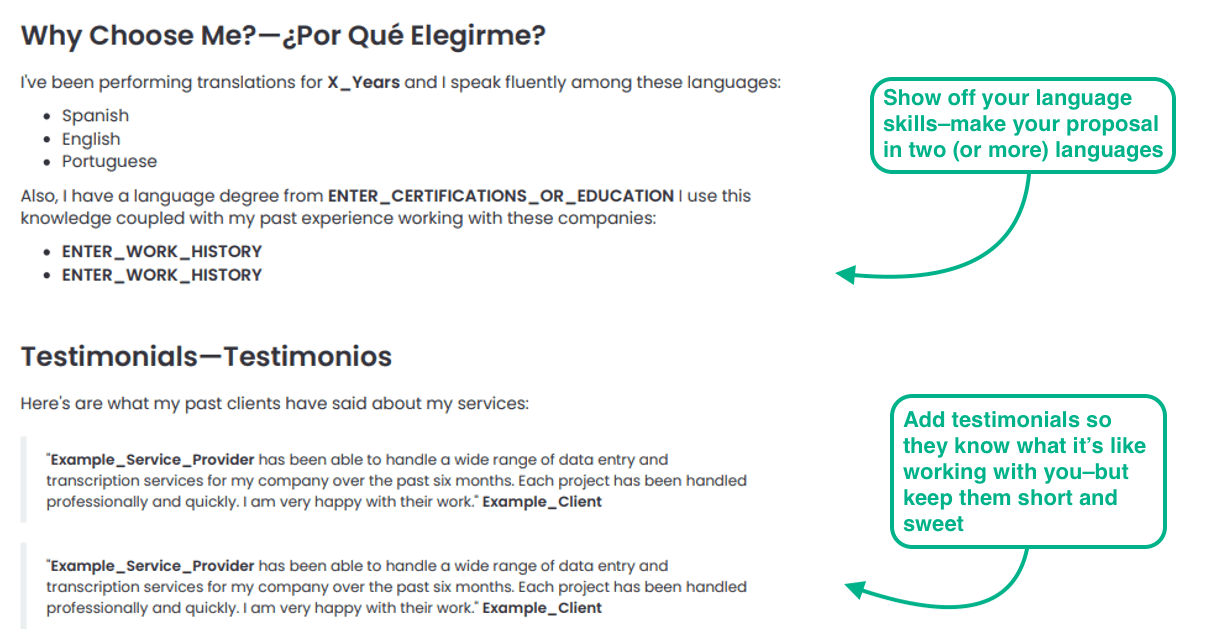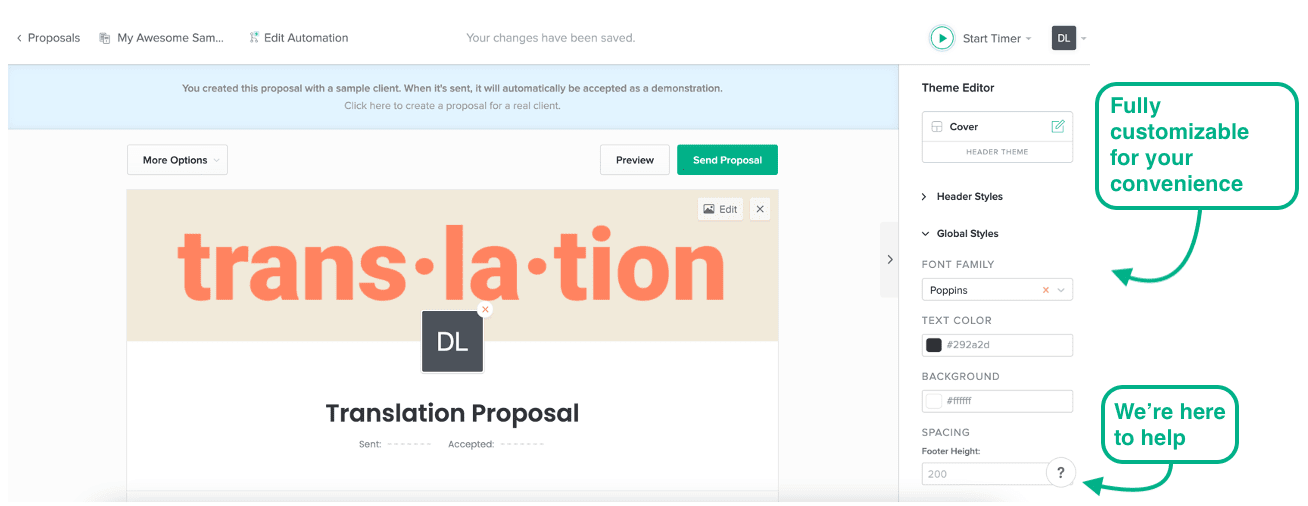What is a translation proposal?
A translation proposal is a document outlining the proposed services offered by a translator to a prospective client. It’s purpose is to convince the prospect to purchase your translation services for a specific project or time period.
A translation proposal is a must for all freelance translators and translation agencies. It not only communicates your offerings, but also your professionalism. It’s a great way to put your best foot forward–given you know how to create a dazzling proposal for your translation services.
Note: Sign up to Bonsai today and gain access to this translation proposal sample, plus hundreds of other free business templates. You can edit and download your client-winning proposal for free.
What to include in a translation proposal template
Picturing the end goal is easy, it’s getting there that’s the tough part. With Bonsai’s polished translation proposal template, all the hard work is done for you. However, if you’re looking to go solo on this–here’s what you’ll need to consider during your proposal writing process.
Cover letter
This is your big first impression–the first thing prospects encounter when reading through your translation services proposal. It’s your chance to communicate your interest in the project and highlight why you’re the perfect fit for the translation project at hand.
Win clients over at hola by including some details about you and your services, and how past experiences make you the perfect translator. You want to express your aptitude for the project, whilst also expressing your interest and commitment to ensuring everything runs smoothly.

Give a brief overview of your proposed approach to the project–this differs depending on the specific project. For example, you’ll approach a written translation differently to how you’ll approach in-person translation services.
Make sure prospects have an idea of your services and solution before diving into the details. If you feel it’s necessary, you can also include an executive summary in your translation proposal. An executive summary gives an overview of the entire project–essentially a TL;DR for your proposal.
Project summary
This is where things get specific–not contract level specific, but still specific. Here you outline the steps you’ll take to ensure the translation project runs smoothly and successfully.
In order to put together a project-specific summary, you need to understand the potential client’s problems and pain points. Without this, your proposal could be considered somewhat of a shot in the dark. If the prospect hasn’t specified the details beforehand, it’s up to you to find out. Get the prospect on a discovery call and ask the key questions.
Consider things like:
- Researching the client and their offerings
- Scheduling a call with prospects to understand the requirements
- Requesting additional information from the request for proposals (RFP)
Having sufficient information to draft your translation proposal template helps make sure that you’re on the right track. Once you’ve got all the info you need, you can begin drafting the scope of work.
Here’s what we recommend including:
- Scope of work: this details the translation service you’ll offer to hit the clients goals. You don’t need to be crazy detailed–this is a proposal not a contract or a service quote, but the specifics are needed.
- Timeline: this indicates how long you expect the project to take. You can separate this into steps, phases, or whatever else you determine is suitable.
- Deliverables: these are key components of a translation project, or any project for that matter. These are another important way of measuring progress, and a great way to highlight your professionalism to the potential client–given you deliver them on time, of course.
The project summary is a key section in all proposal templates–not just a translation proposal template. Whether you’re a freelance translator or a translation company, this section is a must for your sample proposal to win you clients with professionalism.
Translation type
This is where you share your approach to translation. This is a good idea not only because it highlights how you’ll handle this project, but it also shares your other capabilities in case the client has further translation needs.
Here’s where you can share your experience with a number of different types of translation:
- Literary translation: will you be translating stories or poems for this project?
- Professional translation: does this translation need to be hyper-accurate and specific?
- Technical translation: are you translating a guide or a manual?
- Administrative translation: are you translating business documents?
Plus, any other translation type you expect to come up during the project, specify it all here.
Payment schedule and terms
This section is somewhat of a make or break–if your client can’t afford your services then you’re out of luck. Sometimes it happens, and you’re under no obligation to lower your fees. However, if this is a particularly interesting project or a client you hold close to heart–there are definitely ways to make it work.

Again, it’s a good idea to get this information before drafting your translation proposal in order to save time further down the line. Communication is key for winning new customers in your translation proposal template–make sure to listen to client needs and capabilities. Here you’re also making sure you get paid your way for every word translated.
Once you’ve got a better understanding of their budget, look to include:
- Fee summary: these are the expected fees that the client should expect when contracting your translation services–whether that’s a flat rate or an hourly rate.
- Payment schedule: these are payment milestones the prospect needs to adhere to throughout the project. However you prefer to receive payment, clearly outline it here.
- Payment terms: this outlines the terms surrounding payment, such as what happens in the case of late or missed payments.
These key aspects are essential for ensuring you’re happy with the project and how you’ll receive payment. Although this table will sit as a permanent feature in your translation proposal template, you’ll likely change the specifics per project and client.
Closing statement
This is the final section of your translation proposal–and it’s where you need to convince prospects to take the next step. They’ve read many translation proposals, but you want them to pull the trigger on yours.
Include a CTA to encourage prospects to take the first step–this also ensures they know how. You want to be super clear about what comes next, whether that’s a signature, a phone call, a Zoom meeting, or something else.
How to write a polished translation proposal template
Muy bien, now you know what to include in your next translation proposal template. Now it’s time for some tips on how to write a winning proposal.
Here are some things to consider when putting pen to paper–or cursor to Microsoft word.
Highlight what sets your translation services apart
You know your translation service is ready to undergo the project at hand, but it’s the client you need to convince. Include information on what makes your translation services special, and why you’re in the perfect position to complete the task at hand.
Although the meat of this will remain largely the same in your translation proposal template, you’ll want to tweak it depending on the USPs a client views as useful.
Include testimonials from previous projects
Now, you can choose to include this as a section within the proposal, or you can include testimonials throughout the document. Whichever way you decide to approach it, client testimonials are great for instilling a sense of security in your prospects.

Testimonials are proof that you deliver what you promise, and that previous projects have been a success. That’s what the client’s looking for–to rest assured in the knowledge that their project is in safe hands.
How to create a translation proposal with Bonsai
If you’d prefer to avoid the hassle of creating your own translation proposal, why not just use one of Bonsai’s templates. It’s quick and easy–allowing you to focus on the translations at hand.
Here’s how to get started:
- Sign up for Bonsai for free
- Select your translation proposal
- Edit key elements in your proposal template as per your needs
Next, send your proposal to clients for approval without ever leaving the Bonsai platform. Plus, when they accept your fantastic proposal, Bonsai’s got you covered for the rest of the journey–with translation contracts, translation invoices, and more.
Join the 500,000+ freelancers and small businesses already using Bonsai to secure their most important projects–¡adelante!

What are the translation proposal FAQs?
What should I include in a translation proposal?
In your translation proposal you should include:
- Cover letter
- Project summary
- Translation type
- Payment schedule and terms
- Closing statement
You can add sections as you see fit, but this is a solid starting point when offering translation services.
What are the types of translation?
The main types of translation are:
- Literary translation
- Professional translation
- Technical translation
- Administrative translation
These are the main four types of translation, but there are many more–such as judiciary translation, website translation, and legal translation.





